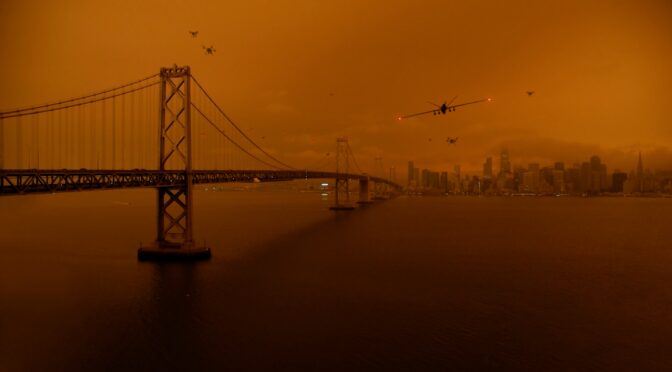 Over the past decade, there has been an inescapable feeling that the world is on fire. Not just in a literal sense, regarding climate change, but also the sense that society and the social contract are burning down around us. Opposition has become polarisation that has not just merely moved the Overton window but smashed it completely. Asif Kapadia attempts to marry archive footage and interviews to a fictional future dystopia to make 2073 a warning to the viewers of 2024 about where we are heading. However, it does this in such a jarring and disconnected manner that Kapadia’s rightful anger at the present is trivialised, and the hypothetical future is rendered meaningless.
Over the past decade, there has been an inescapable feeling that the world is on fire. Not just in a literal sense, regarding climate change, but also the sense that society and the social contract are burning down around us. Opposition has become polarisation that has not just merely moved the Overton window but smashed it completely. Asif Kapadia attempts to marry archive footage and interviews to a fictional future dystopia to make 2073 a warning to the viewers of 2024 about where we are heading. However, it does this in such a jarring and disconnected manner that Kapadia’s rightful anger at the present is trivialised, and the hypothetical future is rendered meaningless.
Kapadia’s polemic darts between two main frames of storytelling: a climate-ravaged dystopian USA (in 2073) scavenged by Samantha Morton, and archival footage and interviews from now and recent history relating to specific figures or collections of events highlighted as possible harbingers of this future. Examples include Rodrigo Duterte’s rule in the Philippines, Narendra Modi’s in India, the advent of Brexit, China’s treatment of Uighur Muslims, and the impact of social media and tech billionaires globally.
An interesting choice made by Kapadia in 2073 is to use archival footage of abuses of power and oppression directly when Morton reflects upon the dystopia she inhabits rather than draw a more oblique parallel. For example, she seemingly observes contemporary police brutality as she skulks outside abandoned Bloomingdale’s stores. However, as the film settles into a pattern of brief and opaque depictions of this crumbling society before flashing back to specific past events, the structural approach and execution become dilutional, trivialising and dampening any anger that might be elicited from the viewer.
“However, as the film settles into a pattern of brief and opaque depictions of this crumbling society before flashing back to specific past events, the structural approach and execution become dilutional, trivialising and dampening any anger that might be elicited from the viewer.”
Part of this is the wildly unclear role of the future that Morton’s character, Ghost, inhabits. The world seen is a grab-bag of science fiction cliches: the orange colour palette of BLADE RUNNER 2049, the Voight-Kampff test of BLADE RUNNER, the hyper-surveillance of MINORITY REPORT (which gets an inexplicable explicit visual reference to Morton’s role in that film), the oppressive Artificial Intelligence of THE MATRIX and THE TERMINATOR. However, Kapadia’s fictional elements belie a misunderstanding of the most effective dystopias in cinema. Thought-provoking science fiction often puts forward a reflection or echo of contemporary issues, not a direct consequence of them.
Much has been made in the promotion of 2073 as being inspired by LA JETEE, the seminal 1962 short film depicting a time traveller trying to save his world’s present. LA JETEE has inspired numerous features and had elements picked up by films (12 MONKEYS even lifts some concepts directly), including some of the aforementioned ones 2073 directly nods to. The conceit latched on to in 2073 seems to be that Morton is conversing with us in the present: “It’s too late for me…but maybe it’s not too late for you.” This message is the only real link to any of the ideas one can draw out from LA JETEE: of how to understand the past, what draws us back to it, and whether we truly have control over our relationship to past, present, and future. In a broader sense, science fiction makes the connection between past, present and hypothetical futures for us thematically, not literally, as 2073 does. This conceit – inverting the notion of ‘a warning from history’ – unforgivably muddies 2073’s message. Are we on a path to an unlivable world and must course correct, or are we already there and should resist and fight back?
“This conceit – inverting the notion of ‘a warning from history’ – unforgivably muddies 2073’s message.”
When dealing with contemporary atrocities and tragedies, this trite approach is confusing at best and distasteful at worst. Using a hokey fictional hook to heighten the impact of the infamous photo of 2-year-old Alan Kurdi – lying dead on a beach in Turkey – feels especially lacking in tact. Jankily rotoscoping Morton into footage of poverty-stricken people raiding landfills is another tonal misstep further degraded by the poor technical quality of the execution.
These misjudgments are unfortunate and surprising given Kapadia’s established skills as a documentarian, and some of the vital lines 2073 draws between malevolent forces. The inextricable link between the rise of autocratic tendencies across the globe (“a global effort to stay in power”), the presence of “totalitarian architecture” of surveillance available to would-be dictators, and the ubiquity and comprehensiveness of personal data gathered by Big Tech are highlighted with the necessary urgency. However, it is immediately undercut by jumping to an empty interrogation sequence devoid of character motivations or stakes.
2073 looks to be a call to action, but its message is rambling, disjointed, and lacking in punch. Many activists over the globe are fighting the forces 2073 points its confused finger at. Hopefully, history will be kinder to them than it should be to this messy expression of solidarity.

